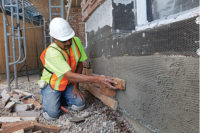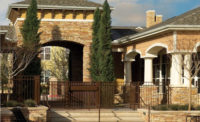Going strong since 1971, Espina Stone Co. boasts skilled craftsmen to work high-quality dimensioned, cut-to-size and hand tooled natural stonework in Metro Washington, D.C. The company, based in Fairfax, Va., has installed natural stone and architectural pre-cast all over Virginia, Maryland, Pennsylvania, West Virginia, North Carolina and Tennessee. Espina Stone’s done numerous stone masonry projects for private and commercial developers for five decades now.
The company’s new stone construction expertise includes stone walls, natural stone paving and natural stone building facades. In addition to new construction, the general contractor and specialty subcontractor also specializes in the restoration and historic preservation of stone structures. Limestone, granite, marble and slate—Espina’s stonemasons are skilled at installing all types of pre-fabricated dimensioned stone. In addition to installing prefabricated stone materials, its masons handcraft and install finished stonework from raw materials quarried to no specific form or dimension, also known as rubble or field stone masonry. Espina Stone also installs architectural pre-cast and brick, and pre-cast concrete paving along with the natural stonework. Through such extensive and varied talents, this allows the company the option to contract a “turnkey” architectural masonry package to its customers.
Most recently, the company was contracted to work on Virginia Polytechnic Institute and State University’s Center for the Arts building over the last year.
Speaking with Walls & Ceilings this spring, Espina Stone’s Vice President Bob Picardi talks of this project, the products used for it, as well as the market and how business is for the company.
“We have seen a fair amount of growth in the commercial area, and especially in education,” Picardi says, adding university projects continue to grow at a steady pace still.
“But business is a little lame right now. We have a decent backlog nucleus of business,” he says, “but we do rely on government work. Some of our clients are limited on what they can put out for bids because of budget constraints and the sequester,” which he says is impacting a lot of his client’s budget funds for work.
ART CENTER
As the centerpiece of a comprehensive arts initiative at the college, the Center for the Arts will be central to reaching the university’s goal to increase the presence and practice of the arts on campus.
Scheduled to open very soon, the Center for the Arts will be a complex of new and renovated facilities that create a vibrant arts facility in the community. Located at the intersection of campus and Main Street, the center will house:
A state-of-the-art, 1,260 seat performance hall where programs can be presented of regional, national and international significance across the genre of music, theatre and dance;
Beautiful visual arts galleries with the infrastructure to support both traditional exhibitions, digital and new media installations;
Creative technology laboratory spaces devoted to the Institute for Creativity, Arts, and Technology, which will provide an applied research environment for faculty, artists, and educators to come together and develop new models, projects and works that are not only artistic efforts, but also tools to directly impact PK-12 education in science, math, social studies, and language arts.
Espina Stone was contracted to apply 27,000 square feet of natural stone veneer to the designs and specs of architectural firm Snøhetta. The stone comes from the university’s own quarry, called Hokie Stone. This stone is hand tooled by Espina Stone’s masons. The company also installed the flashing system for the stone work, anchoring system, Owens Corning’s Foamular rigid insulation board and rainscreen material that backed up the precast elements.
For the rainscreen product, Espina Stone chose Stuc-O-Flex’s WaterWay Plus product because of the success the contractor had using it before. This product is a patented vertical wall rainscreen mat consisting of a nominal 7/16-inch-thick extruded polymer matrix of tangled monofilaments. The monofilaments are heat laminated to a breathable, filter fabric on one side and Typar code-compliant weather resistive barrier on the other side. This multiple layer product creates a one-step weather resistive barrier and rainscreen drainage assembly in a single application. The product is designed for use with manufactured and natural stone—ideal for the Center for the Arts project—as well as traditional and one coat stucco, EIFS, fiber-cement, wood-based sidings, masonry, metal and other wall cladding materials. This rainscreen product provides an uninterrupted drainage path and ventilation for incidental moisture between exterior finish materials and wall sheathing.
Picardi highlights the advantages of using rainscreen instead of the foundation material his company used to use.
“Prior to using rainscreen, we were using a foundation material that was a hard plastic dimple board with a filter fabric over the top of it, so it was much more rigid and difficult to work with,” Picardi says. “The rainscreen serves the same function, is easier to work with and is a cost effective alternative.”
Another bonus of the rainscreen product is that WaterWay Plus will qualify as a LEED product, as the Art Center project is expected to be LEED certified.










Report Abusive Comment